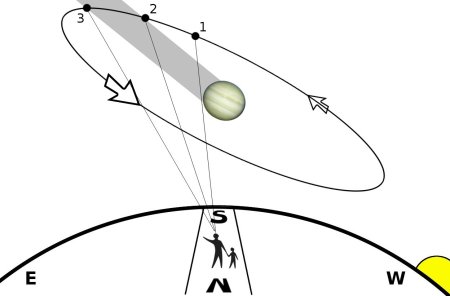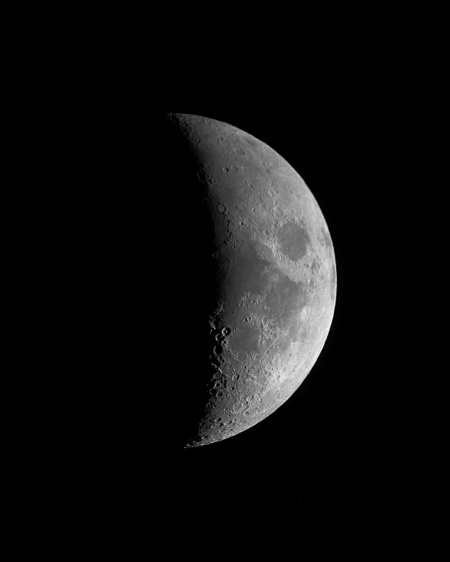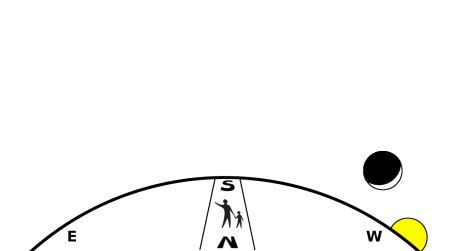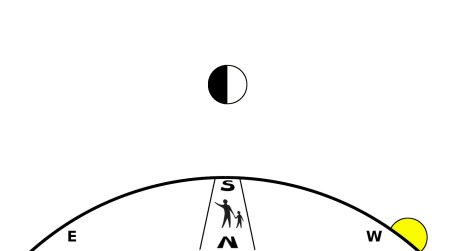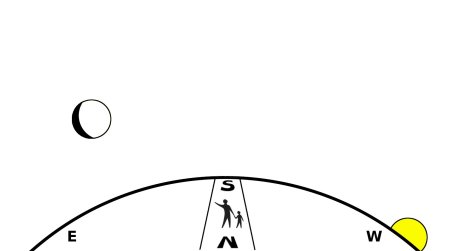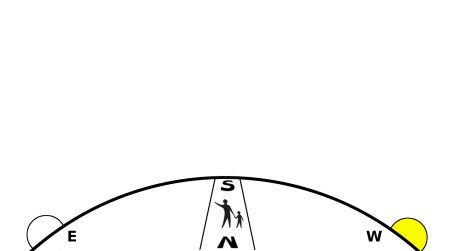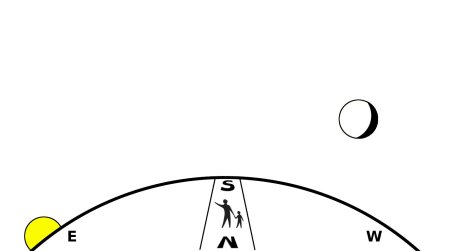Ever since the full moon of January 29, 2010, I’ve been wanting to catch another that was perfectly full. Not a day or even half a day early or late, but right on the button. I came pretty close last Wednesday, August 1. Here’s my best shot, taken with the Nikon Coolpix 4500 shooting through my Apex 127 Mak and 32mm Plossl.
It’s hard to say if this moon is really perfectly full or not; in a way it is, and in a way it isn’t. I know that’s enigmatic, and I’ll clarify it at the end of the post. But first, compare last Wednesday’s full moon to the renowned (by me, anyway) January 29, 2010, moon.
Here, let me make that comparison easier for you. As always, click for the big version.
Two things here are worthy of note. First, there is a difference in illumination. On the left, the east side of the moon is better lit, and on the right, the west.
More importantly, these pictures do not show the same stretch of moon! Check out this overlapped composite, with a few prominent landmarks labelled.
All of the offsets are consistently in the southeast-northwest direction, and the two moons are perfectly overlapped at the periphery. The difference between the images is not because the photographs are rotated in two dimensions, but because the moon was differently rotated in three dimensions. This effect is called libration, and because of it we can see almost 60% of the lunar surface from Earth.
Here’s the comparo again, this time with some of the limb features labelled.
On January 29, 2010, the northwest limb of the moon was tipped toward us, allowing a good view of the “shore” of Oceanus Procellarum and some prominent rim craters like von Braun and its equally-spaced outriders Lavoisier A and Harding. Another useful landmark is the bright crater Seleucus, just to the east of the much larger, dark-floored Eddington. On the opposite limb, Mare Marginis and Mare Australe are barely visible, and Mare Smythii is just a dark patch on the limb itself.
Now compare to last week’s fully moon. The northwest limb is rotated so far away that von Braun is completely lost, along with the rest of the shore of Oceanus Procellarum, and Eddington is a barely perceptible dark streak. On the other hand, the southeast limb shows excellent detail in Mare Australe, especially around the very dark-floored craters Lyot and Oken, and farther north we can see all the way across Mare Smythii to the lighter terrain beyond.
Now, as to the “perfection” of the fullness: there is some terminator-like shadow and detail visible in my photo from last week, but not on the eastern limb where one might expect it. Instead, all of the visibly shadowed craters are around the south pole. This is where the story gets complicated.
There are three widely-discussed causes of libration: (1) the moon leading or lagging, relative to its own rotation, along its eccentric orbital path; (2) the tilt of the moon’s axis relative to the plane of its orbit; and (3) rotation of the Earth, which from moonrise to moonset carries an Earthbound observer almost 8000 miles from west to east (which is why everything in the sky rises in the east–that’s the direction we’re constantly headed here on the surface). The moon is only 240,000 miles away, so this daily (or nightly) trip equals 1/30 of the distance from Earth to the moon. How much difference does that make? The average interocular distance for a human is 6.5 cm (2.5 inches), so look at something 30 times farther away (195 cm or just over 6 feet) first with one eye and then with the other. You just simulated diurnal libration.
Now, as I noted above, the eastern limb of the moon is darker than the western side in last week’s photo. The Sky & Tel online almanac said max fullness would be at 8:37 PM, PDT. But the moon was just rising then, about four hours before it would cross the local meridian. In other words, at max fullness the moon was dead overhead for people 4000 miles west of me, but the turning Earth wouldn’t carry me directly under the moon for another four hours–and by the time I got there, it wouldn’t be perfectly full anymore. I took the picture I used in this post at about 11:30–three hours too late for a perfectly full moon. I took other pictures at 8:37 and other times in between, but they turned out poorly–seeing near the horizon was rotten and my scope wasn’t properly cooled yet.
So I’m pretty sure that diurnal libration–the effect of the turning Earth–accounts for the less-than-even illumination from east to west in my moon shot. But that doesn’t explain why there are shadows at the south pole. I assume that the alignment of the moon and Earth was such that I was looking up the moon’s skirts, so to speak–so far south, relative to the moon, that I could see past the illuminated area and into the shadowed highlands beyond. If that’s true, then observers in the Southern Hemisphere, being even farther “below” the moon, should have been able to see even farther into the shadowlands.
The moral of the story is that if you want a good photo of the perfectly full moon, it’s not enough that the moon be visible in the sky at the moment of max fullness–you should also be right underneath it (it should be as high in the sky as it is going to get). Even if you get good enough seeing to get a clean shot of the moon low in the sky, you’ll be several thousand miles to one side or the other, and you won’t be seeing it face-on. On the flip side, if you catch the rising full moon a few hours before max fullness, or the setting full moon a few hours after, you might still get a fully-illuminated disk, because Earth’s rotation will put you along the same line as the incoming light. Sounds a bit hairy, but as Timothy Ferris wrote of making chancy observations, “You can’t catch any fish if you don’t get your line wet.”
Anyway, I had a lot of fun, and got a good look at some southeast limb features that I’d never seen before. I’m anxious to see what libration will bring me next.











